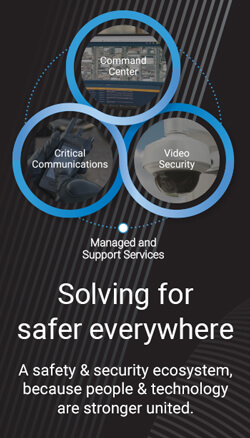You have varying responsibilities to your school community—and plenty of them.
To educate and nurture. To delegate and lead. But most importantly, to prioritize your students’ safety at all times. From the moment students board the morning bus to after-school activities and every minute in between, it’s up to your faculty and staff to be attentive, aware, and connected at all times.
But that’s easier said than done. There are many things to consider when devising a solution for your communication needs. Everything—from the size and scale of your campus to connectivity issues and cost-effectiveness—factors into your decision-making.
Chances are that you’ve run into an issue or two regarding your current setup. Is there a simpler solution?
We’ve compiled a few of the top challenges that schools face with their communication systems. If any of them ring a bell, you’re in luck: Help is well within reach. As a Motorola partner, Electronic Service Solutions is well equipped to provide any of the products and services listed below.
Take a look at these common problems and how Motorola technology can make them disappear.
Faulty Communication Across Campus
The problem: Connectivity issues are all too common on campuses. Often, the reasons for faulty connectivity are out of your control: the materials used to construct your building, its inconvenient location, or an issue with your internet and cell providers. Thus, your campus might be settling for spotty service or resorting to landlines for communication.
When communication across your campus is interrupted or impossible, you’re bound to suffer the consequences. Disorganization, inefficiency, and the inability to push important updates are just a few of the side effects. Your faculty members are also likely irritated when they can’t contact their supervisors or colleagues with status updates or emergency notices.
Whether you’re driving your morning bus route across the county or supervising the school halls, you should be able to quickly and easily contact any member of the school faculty.
The solution: Don’t rely on shaky cell connectivity for important communication—instead, use two-way radios. In 2017, 30% of schools were using two-way radios as their main source of communication—that percentage has only increased as more campuses have recognized the uninterrupted coverage, high audio quality, and long battery life of Motorola digital technology.
Recommended products: WAVE PTX. This broadband push-to-talk solution from Motorola connects MOTOTRBO radios to non-radio users with an app installed on their smartphones. And because today’s smartphones can connect across both cellular and Wi-Fi networks, the WAVE mobile app allows school personnel to communicate with individual buses or groups of buses over MOTOTRBO radio channels.
Bus Communication
The problem: While smartphones are versatile and convenient to use 24/7, their functionality doesn’t always hold up—especially on the job. The moment a bus driver loses their phone, runs out of battery, or suffers connectivity issues, the simple necessity of communication is compromised for your entire fleet of employees.
This problem speaks for itself: Without reliable communication, your bus drivers are unaware of any scheduling updates, route changes, or emergencies. That can cause delays, pave the way for mistakes, and potentially put your staff members and students in danger.
The solution: MOTOTRBO™ mobile radios will keep your drivers connected no matter how dispersed your buses are. Keep in touch at all times with ease and confidence by linking your vehicles to the same system—no more worrying about cell service or misplaced smartphones when all you need is already installed right inside your buses.
Recommended products: MOTOTRBO XPR 7000e portable radios. Superintendents from Elmore County Public Schools can attest to the adaptability and quality of these devices for buses and transportation services.
Tracking Buses
The problem: When buses are transporting your students to home, school, field trips, or sporting events, you—and parents—will want to know that everything is safe and on course. Without a reliable way of tracking your bus routes, you can’t keep tabs on your vehicles and the students. Plus, you can’t be expected to interrupt preoccupied drivers for status updates every few minutes.
This means you’ll run the risk of providing inaccurate updates to anyone waiting on a bus to arrive: Parents, babysitters, trip leaders and other expectants won’t be pleased by uninformed delays, bad information, or unanticipated schedule changes.
The solution: GPS features integrated into your radio system will alleviate any concerns regarding your transportation fleet. Has there been a delay due to traffic? Is a student on the correct bus? Did one of your drivers violate a traffic law or speed limit? All of these questions and more can be answered at a moment’s notice with GPS technology.
Recommended products: There are a number of GPS antennas that can be installed to mobile and portable radios. Finding the right fit for your product is as easy as getting in touch with one of our representatives.
Contacting Emergency Services Efficiently
The problem: Whether a routine sports injury requires medical attention or a student is reported missing, a direct line of communication with 911 is vital. Should an emergency arise, every second counts towards getting the help you need. Your staff must be capable of contacting emergency services no matter where the incident occurred on your campus.
The solution: Upgrading your radios with compatible apps can better equip them for fast-paced emergency situations. Interoperability with your telephone system means that any school employee can make a call from a radio directly to 911 dispatchers.
Recommended products: The Teldio app goes beyond basic telephone interconnects by giving radio users access to familiar phone-like features. It’s compatible with MOTOTRBO™ radios and makes placing emergency calls to 911 effortless.
Knowledge Center
- How To Prepare A Successful Grant Application
- Safe School Solutions – from Detection to Response
- JVC KENWOOD Announces Cleaning and Disinfecting Guidelines for KENWOOD Radios & Accessories
- Introducing APX Next – A Revoloution In Public Safety Communication
- 3 Ways to Improve the Safety of a Healthcare Facility
- Security Communications: Connecting Schools & Communities with Interoperability
- 5 Industries That Need Motorola Solutions
- Two-Way Radios: Healthcare Communication Tools
- Communication & Operation Solutions for the Manufacturing Industry
- Education Communication: 4 Common Challenges (and Solutions)

